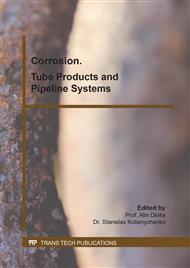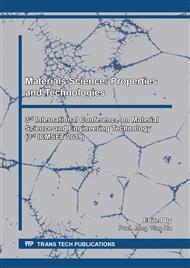p.69
p.73
p.79
p.85
p.91
p.97
p.103
p.109
p.115
Analysis of the Causes of Tube and Pipeline Blocking in Sulige Gas Field
Abstract:
A large number of blockage appeared in gas wells and pipeline appeared, which causedplugging, corrosion and the increasing of wellbore pressure difference, and seriously affect thenormal production of gas well of problems. In this paper, the water quality of produced water fromthe severe cases of single wells or pipeline water were analyzed, also include the composition ofblockage and core with the chemical volumetric method (CVM) , X-Ray Diffraction (XRD) and x-rayfluorescence (XFS) method. Meanwhile, the core powder was leached in simulated acid worksolution, and then the leaching solution was analyzed with CVM. The experimental results show thatThe produced water has high salinity, high contents of Ca2+, Ba2+ and Sr2+, low pH value, which leadto corrosion and scaling. The main components of the blockage are acid insoluble strontium sulfate(barium) scale or corrosion product or mixture of corrosion and CaCO3 scaling product. Ca2+, Ba2+and Sr2+ were easy to scale in wellbore or pipeline when they encountered other produced water fromdifferent formation. The Ca2+, Mg2+, Ba2+, Sr2+ and Fe 2+/3+ mainly derived from the dissolution offormation debris in formation water and working fluid (especially acidic working fluid) to reservoirrock, so the salinity of the produced water increased, and the trend of scaling and corrosion alsoincreased with the gas field development.
Info:
Periodical:
Pages:
97-102
Citation:
Online since:
August 2019
Authors:
Price:
Сopyright:
© 2019 Trans Tech Publications Ltd. All Rights Reserved
Share:
Citation:



